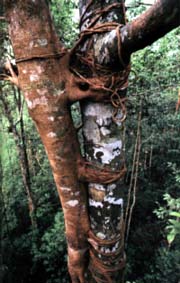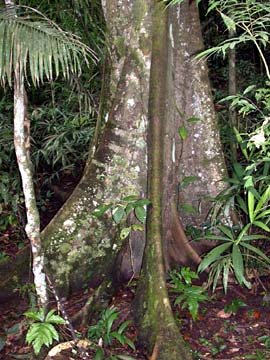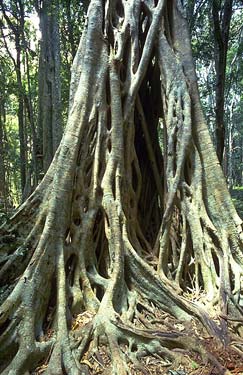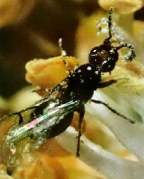|
|
|
|
| |
|
|
| |
|
|
|
| |
Strangler
figs, called gameleira in Brazil, are one of the most important
plant species of the rainforest ecosystem. There are close to 1,000 different
species of ficus, which can be found in every major rainforest,
tropical continent or island around the world. Hundreds of animals like
pigeons, parrots, hornbills, toucans, monkeys, gibbons, and fruit-eating
bats feed on the sweet fruit of the fig tree. Strangler figs are tall canopy
trees which can grow to 148 feet in height. The manner in which they reach
the canopy is a strange story. The forest floor of a rainforest is a difficult
place for seedlings to grow. There is little light and a lot of competition
for water and nutrients. Strangler figs have made an adaptation to avoid
these difficulties. Unlike most plants, strangler figs start out their lives
as epiphytes in the crook of a tree or on its branches. Tiny, sticky
seeds are deposited high in a tree by animal droppings. The seeds are not
affected by the animal's digestive tract and soon germinate. |
|
|
| |
|
|
|
| |
|
|
|
| |
|
The
strangler fig has an aggressive growth habit that insures its survival in
the rainforest. The seedlings grows slowly at first, getting their nutrients
from the sun, rain and leaf litter that has collected on the host. The stranglers
send out many thin roots that snake down the trunk of the host tree or dangle
as aerial roots from its branches. When the roots reach the ground they
dig in and put on a growth spurt, competing with the host tree for water
and nutrients. They also send out a network of roots that encircle the host
tree and fuse together. As the roots grow thicker they squeeze the trunk
of its host and cut off its flow of nutrients.In the canopy the strangler
fig puts out lots of leaves that soon grow thicker than the host tree and
rob it of sunlight. Eventually the host dies from strangulation, insufficient
light and root competition, and the strangler fig stands on its own. A hollow
center is all that remains of the host. |
|
| |
|
|
|
| |
|
|
|
| |
Some
figs grow root systems that develop into thin buttresses that can spread
out to a distance of about 30 feet. Other figs grow aerial roots from their
branches that, when they reach the ground, root themselves and become another
trunk on the same tree. Strangler figs have light colored bark and umbrella
shaped canopies. Green above and lighter below, the leaves are simple, ovoid
and usually between 1.5 - 3 inches long. Waxy leaves protect the strangler
fig from drying winds and the sunlight that it is exposed to high in the
canopy. Perhaps the most amazing part of this extraordinary tree is its
flower. What we think of as the fruit is really a hollow, flower-bearing
structure called a cyconia. The inside it is lined with hundreds
of male and female flowers. The males carry pollen and the females bear
seeds. There are two different types of female flowers; one with a short
style and one with a long style. |
|
|
| |
|
|
|
| |
|
|
|
| |
|
Now, if that isn't
weird enough, each species of fig has a symbiotic relationship with its
own species of tiny pollinator wasps. These wasps are less than a millimeter
in length, and enter the cyconia through an opening at the bottom
of the fruit. Once inside, they pollinate the long-styled female flowers
in the process of lying their eggs in the ovaries of short-style flowers.
Without these special wasps carrying pollen from one cyconium to
another there would be no seeds. |
|
| |
|
| |
|
| |
When the
eggs hatch, two kinds of wasps emerge; a female and male. When the male
hatches it finds a short-style flower and bites a small hole in the ovary
wall. It then inseminates the female through the hole and repeats the process
with every female it finds. The female will then crawl out of the hole made
by the male. As a last act in its short life the male will chew through
the cyconium wall to the outside. The females are then able to leave and
repeat the process of pollination and egg lying in other figs. |
|
| |
|
| |
The
above text is part of an article by E. Benders Hyde that I found on the
web:
http://www.blueplanetbiomes.org/strangler_figs.htm. |
|
| |
All photos on
this page are from the web . |
|
|
| |
|
|
| |
|
|
|
| |
Gameleiras,
or banyan trees, are considered holy in African and Afro-Brazilian cultures.
The same applies to the two great Asian religions, Buddhism and Hinduism.
|
|
| |
|
|
| |
Gautama
Siddhartha was filled with many questions and wanted to know the truths
of life. He set out on his own to "find himself". Seven years
went by and he had not found what he was looking for and traveled to Bodhgaya,
India. He sat under a pipal tree and decided not to get up until he attained
enlightenment. No one knows the exact length of time he spent under the
tree; different stories vary. Guatama became enlightened or reached nirvana
and became the Buddha or Awakened One. The pipal tree became known as the
Bodhi or "Enlightened" tree, and soon after, the Buddha's followers
saw the tree as sacred. |
|
| |
|
|
|
| |
The
bodhi tree (Ficus religiosa), also known as banyan, bo, or pipal tree, comes
from the Asiatic fig. It starts it's life as an epiphyte and can grow to
one-hundred feet. It's big roots sustain the long extended branches. The
bodhi tree continually rejuvenates by rooting it's branches in the soil.
To some, the bodhi trees are believed to be immortal. One sacred bodhi tree
in Sri Lanka is thought to be 2200 years old. The continuous life of these
trees is what might have gave them their sacred symbolism in the Buddhist
religion. Like the bodhi tree, Buddhist religion teaches that when we die,
we move on to a different life and possibly in a different form, but we
are never really dead, we "rejuvenate". |
|
| |
|
|
|
| |
In
Hinduism, the banyan/fig tree, called Ashwatta, is considered to
be very sacred and worshipped as the abode of the trimurthis, as the following
sloka states:
Moolatho Brahma Roopaya, Madhyato Vishnu Roopini, Agratas Shiv Roopaya,
Vriksha Rajayte Namaha.
Brahma shaped at the root, Vishnu shaped in the middle and Shiva shaped
at the top, we salute you, the king of all trees. |
|
| |
|
|
|
| |
Hinduism
itself is likened to a giant banyan tree: |
|
| |
We
can define Hinduism as a set of religious beliefs, practices, and traditions
that has been gradually evolving over a period of time in the Indian subcontinent
with its primary roots in the Vedas but like a giant banyan tree with its
secondary roots deriving succor from all directions and various sources,
providing shelter to many divergent beliefs and practices and still spreading
farther and farther from its base. |
|
| |
|
|
|
| |
|
|
| |
|
|
|
| |
This
page has loaded in a separate window, you can close it when you're finished. |
|
| |
|
|
| |
In case you came here directly and not from my Brazil pages,
please click here to get to the Brazil starting
page. |
|
| |
|
|
| |
|
|
| |
back
to main index
|
|




